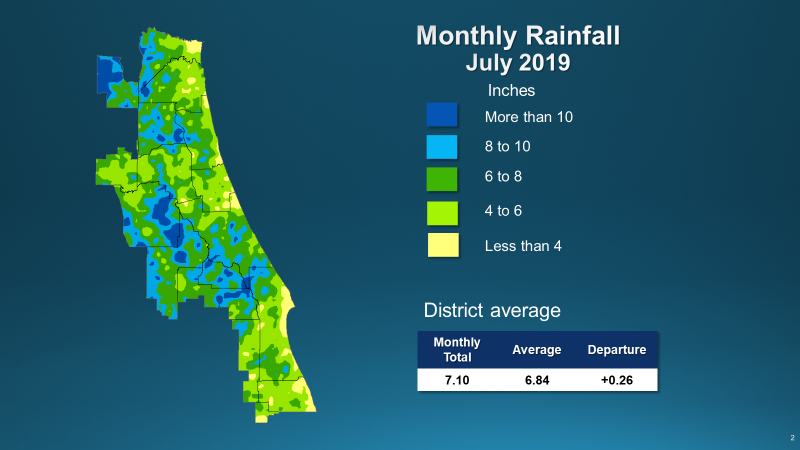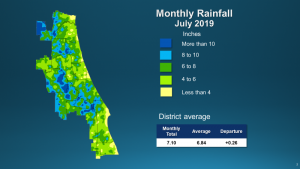Above-average July rainfall in most areas, but drier along the coast

A map illustrates rainfall conditions across the St. Johns River Water Management District.

A map illustrates rainfall conditions across the St. Johns River Water Management District.
PALATKA, Fla., Aug. 13, 2019 — Data collected by the St. Johns River Water Management District shows July 2019 rainfall was above average in most areas of north and central Florida, but some coastal areas, particularly in the southern portion of the district, were drier.
A full report outlining hydrological conditions was presented at the district’s August Governing Board meeting.
Indian River and Brevard counties recorded 5–6 inches of rainfall during July. For the 12-month average, Indian River County has a cumulative total of less than 35 inches, while Brevard and Osceola counties have under 42 inches. While conditions are drier than normal, the good news is that the southern end of the district has available water storage if the hurricane season becomes active.
On the northwesterly side of the district, portions of Baker County recorded more than 10 inches and Marion County recorded nearly 9 inches of rainfall during July.
In the north, Duval, St. Johns and Putnam counties received 6-7 inches of rainfall in July. Coastal counties of Flagler and Volusia counties recorded 5.4 inches and 7 inches, respectively.
In central Florida, Seminole County received 8.5 inches, while Lake County received 8 inches, and Orange County tallied nearly 7 inches.
Other highlights include:
- Upper Floridan aquifer conditions (groundwater levels) were in the normal to high range across most of the district, other than a small area of southeast Duval and northeast St. Johns counties with groundwater levels in the low range.
- Surface water flows in north and central Florida were in the high to very high range, mirroring rainfall.
- Surface water stations in the Upper St. Johns River Basin showed improvement, with the Melbourne station reporting in the average range for the first time since March.
- Lake levels across the district increased slightly.
To learn more about rainfall totals, visit www.sjrwmd.com/data.

